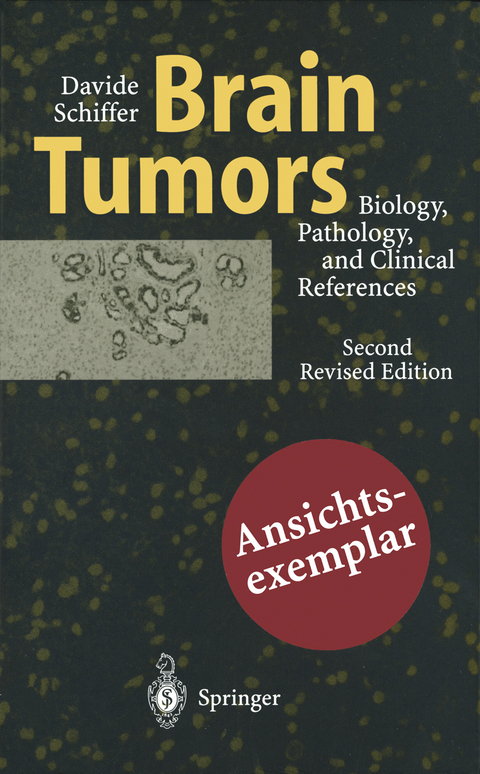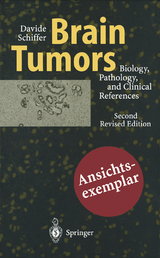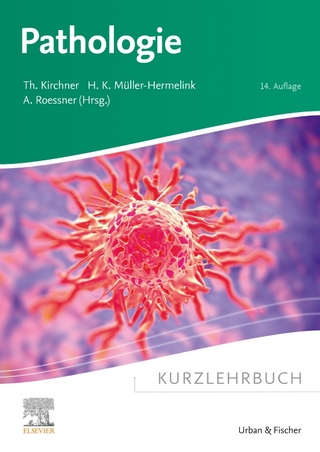Brain Tumors
Springer Berlin (Verlag)
978-3-642-64445-0 (ISBN)
1 Cytogenesis of the Central Nervous System.- 1.1 Neurogenesis and Gliogenesis.- 1.2 Gliogenesis in Adult Animals.- 1.3 Development of the Cerebellar Cortex.- 1.4 Radial Glia and Ependyma.- 1.5 Genes Controlling Nervous System Development.- 2 Factors of the Transformation Process.- 2.1 Genetics and Molecular Biology.- 2.2 Familial Incidence of Tumors.- 2.3 Congenital Tumors.- 2.4 Risk Factors: Epidemiological Data.- 3 Experimental Tumors.- 3.1 Chemical Carcinogenesis.- 3.2 Viral Carcinogenesis.- 3.3 Transplantable Animal Models.- 3.4 Gene Transfer Models of Neural Tumors.- 4 Antigens of Phenotypic Expression and Differentiation Markers.- 4.1 Brain Tumor-Associated Antigens.- 4.2 Antigens Employed in the Histological Diagnosis of Brain Tumors.- 5 Pathology of the Host-Tumor Interaction.- 5.1 Peritumoral Changes.- 5.2 Regressive Events in the Tumor.- 5.3 Cerebral Edema.- 5.4 Calcifications.- 5.5 Immune Response.- 6 Classification and Nosography of Neuroepithelial Tumors.- 7 The Concept of Malignancy: Anaplasia, Cell Proliferation, Metastasis.- 7.1 General Considerations.- 7.2 Cell Kinetics.- 7.3 Metastasis.- 7.4 Expansion and Invasiveness.- 8 Descriptive Epidemiology of Primary Nervous System Tumors.- 8.1 General Data.- 8.2 Epidemiology of Intracranial Tumors.- 8.3 Epidemiology of Intraspinal Tumors.- 9 Astrocytic Tumors.- 9.1 Nosological Problems.- 9.2 Astrocytic Tumors of the Cerebral Hemispheres.- 9.3 Astrocytic Tumors of the Midline.- 9.4 Astrocytic Tumors of the Spinal Cord.- 10 Oligodendroglial Tumors.- 10.1 Oligodendroglioma.- 10.2 Presence of Astrocytes and the Problem of Mixed Gliomas: Oiigoastrocytoma.- 10.3 Anaplastic Oligodendroglioma and Prognosis.- 11 Ependymal Tumors.- 11.1 Ependymoma.- 11.2 Subependymoma.- 11.3 Ependymoblastoma.- 12 Choroid Plexus Tumors.-12.1 Plexus-Papilloma.- 12.2 Malignant Variant (Plexus Carcinoma).- 13 Tumors Composed of Neural Cells.- 13.1 Ganglioglioma (Gangliocytoma).- 13.2 Dysplastic Gangliocytoma of the Cerebellum.- 13.3 Infantile Desmoplastic Ganglioglioma -Desmoplastic Infantile Astrocytoma.- 13.4 Central Neurocytoma.- 13.5 Dysembryoplastic Neuroepithelial Tumors.- 13.6 Olfactory Neuroblastoma.- 14 Pineal Gland Tumors.- 14.1 The Pineal Gland.- 14.2 Pineal Gland Tumors.- 14.3 Pineal Cysts.- 15 Embryonal Tumors.- 15.1 Medulloepithelioma.- 15.2 Medulloblastoma.- 15.3 Neuroblastoma.- 15.4 Polar Spongioblastoma.- 15.5 Appendix: Tumors of the Retina.- 16 Glomus Tumors, Paragangliomas.- 16.1 Site, Age, and Clinical Features.- 16.2 Macroscopic Appearance and Imaging.- 16.3 Microscopic Appearance.- 16.4 Prognosis.- 17 Tumors of the Cranial and Spinal Nerves.- 17.1 Neurinoma (Schwannoma).- 17.2 Neurofibromas.- 17.3 Granular Cell Tumors.- 17.4 Neurothekeoma.- 17.5 Perineurioma.- 17.6 Prognosis, Malignancy.- 18 Tumors of the Meninges.- 18.1 Meningiomas.- 18.2 Other Mesenchymal Tumors of the Meninges.- 19 Mesenchymal Tumors.- 19.1 Chordomas.- 19.2 Chondroma.- 19.3 Chondrosarcomas.- 19.4 Osteomas.- 19.5 Osteosarcoma.- 20 Vascular Tumors.- 20.1 Capillary Hemangioblastoma.- 21 Tumors and Dysontogenetic Lesions.- 21.1 Germ Cell Tumors.- 21.2 Teratomas.- 21.3 Tumors with Muscle Cells.- 21.4 Dermo-epidermoid Cysts.- 21.5 Craniopharyngioma and Epithelial Cysts.- 21.6 Neuroepithelial and Non-Neuroepithelial Cysts.- 21.7 Lipomas.- 21.8 Hamartomas, Ectopias, and Ectopic Tumors.- 21.9 Hamartomas or Vascular Malformations.- 22 Phakomatosis and Dysgenetic Syndromes.- 22.1 Tuberous Sclerosis (Bourneville's Disease).- 22.2 Neurofibromatosis.- 22.3 Von Hippel-Lindau Syndrome.- 22.4 Sturge-Weber Syndrome.- 22.5 OtherDysgenetic Syndromes.- 23 Primary Central Nervous System Lymphomas.- 23.1 Frequency, Age, Site, and Clinical Features.- 23.2 Macroscopic Aspect and Imaging.- 23.3 Microscopic Appearance.- 23.4 Epidural Lymphomas.- 23.5 Lymphomas in AIDS.- 23.6 Prognosis, Treatment.- 24 Metastases.- 24.1 Frequency.- 24.2 Sex.- 24.3 Age.- 24.4 Metastatic Pathways.- 24.5 Macroscopic Appearance and Imaging.- 24.6 Microscopic Appearance.- 24.7 Differential Diagnosis.- 24.8 Prognosis and Therapy.- 24.9 Carcinomatous Meningitis.- 24.10 Spinal Metastases.- 25 Biological Basis of Therapies.- 25.1 Radiotherapy.- 25.2 Chemotherapy.- 25.3 Immunotherapy.- 25.4 Biologic Therapies.- 26 Effects of Treatment on Brain Tumors and Normal Nervous Tissue.- 26.1 Effects of Radiotherapy and/or Chemotherapy on Human Brain Tumors.- 26.2 Effects of External Radiotherapy on the Human Brain.- 26.3 Effects of Brachytherapy on the Human Brain.- 26.4 Effects of External Radiotherapy on the Human Spinal Cord and/or Nerve Roots.- 26.5 Pathogenesis of Adverse Effects of Radiotherapy on the Normal Nervous Tissue.- 26.6 Effects of Chemotherapy on the Human Brain and Spinal Cord.- 26.7 Effects of Treatment on Normal Nervous Tissue in Acute Lymphocytic Leukemia of Childhood.- 26.8 Second Malignancies.- References.
| Erscheint lt. Verlag | 27.9.2011 |
|---|---|
| Mitarbeit |
Assistent: M.T. Giordana, A. Mauro, R. Soffietti |
| Zusatzinfo | XX, 695 p. |
| Verlagsort | Berlin |
| Sprache | englisch |
| Maße | 155 x 235 mm |
| Gewicht | 1070 g |
| Themenwelt | Medizin / Pharmazie ► Medizinische Fachgebiete |
| Studium ► 2. Studienabschnitt (Klinik) ► Pathologie | |
| Schlagworte | brain • brain tumor • Brain Tumors • Pathology • Tumor |
| ISBN-10 | 3-642-64445-7 / 3642644457 |
| ISBN-13 | 978-3-642-64445-0 / 9783642644450 |
| Zustand | Neuware |
| Informationen gemäß Produktsicherheitsverordnung (GPSR) | |
| Haben Sie eine Frage zum Produkt? |
aus dem Bereich




